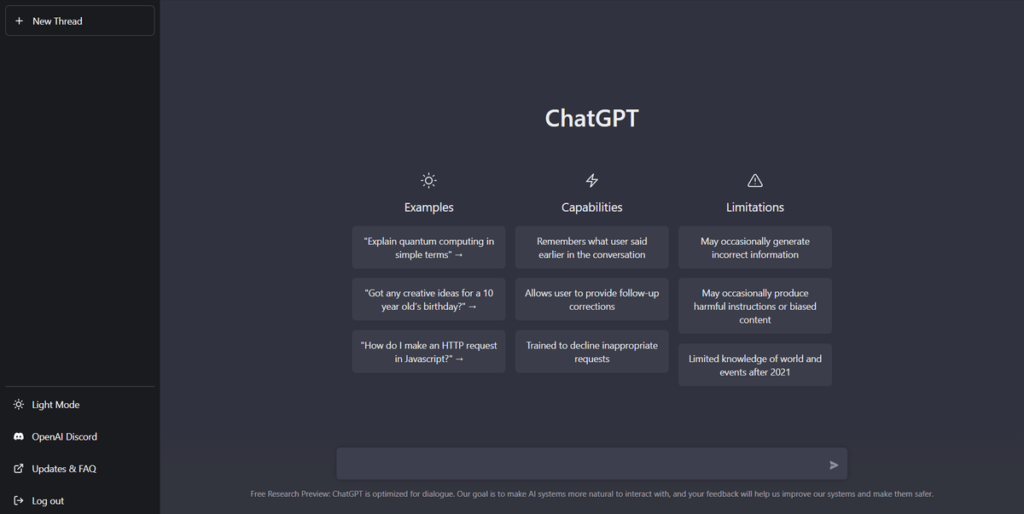
An artificial intelligence-powered chatbot that is brand-new has become popular online.It responds to inquiries from people in an uncannily lifelike, conversational, occasionally hilarious, and occasionally scary and problematic way.
According to company representatives, the technology, which was developed by the same company that designed the text-to-image converter Dall-E, has amassed more than a million users since it was released last week.
So what is ChatGPT exactly?
The organization’s ChatGPT project aims to make “talking” with an AI seem easy and natural, almost like a discussion between people.
Users can query the AI in a feature analogous to instant messaging to learn more about the information acquired for the model. In an effort to mimic the flow of a conversation, ChatGPT will respond to requests with whole phrases. However, keep in mind that they aren’t always appropriate or correct.
Who is the creator of OpenAI and ChatGPT?
The language model was developed by OpenAI, a San Francisco research center that was established in 2015 with a $1 billion pledge from its founders, including its CEO Sam Altman, Elon Musk, and billionaire entrepreneur Peter Thiel.
In 2018, Musk severed his links with the company. Musk, who this fall paid $44 billion to acquire Twitter, claimed that he learned OpenAI had access to Twitter’s database for training data when ChatGPT began swiftly taking over Twitter.
How does it operate?
It employs a big language model, an artificial intelligence (AI) system that has been trained to anticipate the next word in a sentence by ingesting sizable amounts of internet-based content and discovering patterns through trial and error. ChatGPT was modified in response to user feedback so that it could speak as naturally as a robot in 2022.
- At its core, ChatGPT is a massive language model that employs algorithms to a vast corpus of frequently taken directly from the internet content in order to respond to user inquiries in a way that can sound surprisingly human.
- A method known as reinforcement learning with human feedback is used to enhance ChatGPT.
- To interact with the model while playing the parts of both a user and a chatbot, the company hired “human AI trainers.”
- Trainers evaluated the quality of ChatGPT’s written responses against those of real individuals to reinforce humanlike conversational methods.
How To Use ChatGPT?
People can test out the technology by signing up for an account with OpenAI and reading through a few brief disclaimers.
Users are cautioned not to enter sensitive information and are informed that the technology may use generated findings to improve its training.
How can you create an OpenAI account for ChatGPT?
Go to the OpenAI website and look for the “Introducing ChatGPT” banner.
When you click “Try,” a log-in option will appear. – The website will ask you to create an account by providing your email address and a new password. Then, you will be asked to validate your email.You can ask questions by choosing the “Playground” option once the setup is complete.
Using ChatGPT an iPhone
There isn’t a standalone ChatGPT app available for the iPhone or iOS as of yet.Regardless, you can access it through the GPT-3 API or the OpenAI website. Utilising it via the OpenAI website is the most straightforward method. You’ll need to use one of your iPhone’s online browsers, such as Safari or Chrome, for that. A service or programme that is compatible with the GPT-3 API must be purchased in order to use it.
Using ChatGPT on an Android device
It is not feasible to use ChatGPT on Android. The functionality is the same whether using an iOS device or a browser. Google Chrome, Firefox, Brave, and Opera are just a few of the browsers you can use. To use the chatbot, go to the OpenAI website. For quick access, save the webpage to your home screen or bookmark it.
How precise is it?
When you first utilize the technology, a disclaimer notifies users that ChatGPT is not always correct.
OpenAI, a business founded a few years ago with funding from Elon Musk and others, warns that ChatGPT isn’t perfect and occasionally offers inappropriate or misleading information. That hasn’t stopped social media users from asking fresh questions and posting the responses online, either.
When examined more closely, the model’s written responses may appear plausible, but they actually contain mistakes. There are growing concerns regarding how soon this form of AI could be relied upon without human supervision due to the frequency of falsehoods, gibberish, or minor errors.





